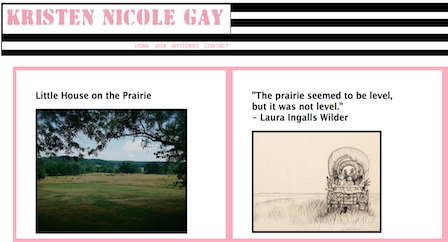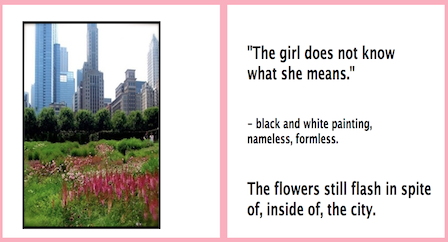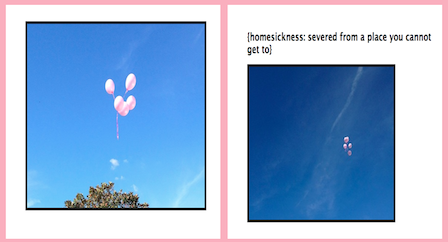Our [Electrate] Stories
Explicating Ulmer's Mystory Genre
Marc C. Santos, Ella R. Bieze, Lauren E. Cagle, Jason C., Zachary P. Dixon, Kristen N. Gay, Sarah Beth Hopton, Megan M. McIntyre
Reflection: Kristen N. Gay
1. What work does a mystory do?
In Electronic Monuments, Gregory L. Ulmer (2005) wrote, "The goal of the mystory, to use Nietzsche’s phrase, is 'to find that secret point at which the aphorism of thought intersects with the anecdote of life’" (p. 21). By asking students to trace the anecdotes that (in)form them within their career, family, entertainment, and community discourses, Ulmer’s (2003) project in Internet Invention instigated a personal unfolding and a shift from a literate person “reason[ing] on paper” to “an electrate person feel[ing] online” (p. 145). This project has several goals, one of which is “to make this virtual option a viable one for political and ethical action, to help write ‘murder’ out of the equation” (Ulmer, 2003, p. 177). Ulmer’s mystory, then, works to prepare egents for political and ethical action in virtual spaces.
My attunement to embodied writing highlights a connection between Ulmer’s project and Donna J. Haraway’s (1988) call in “Situated Knowledges: The Science Question in Feminism and the Privilege of Partial Perspective” for reclaiming a sense of “vision” for feminist epistemology that is situated, positioned, agentive, collective, engaged, uncertain, finite, and, most importantly, multiple (p. 373). This, I think, is also Ulmer’s (2003) approach to felts, since he explained that the “mystory is not a text, but a ‘felt’ . . . whose overtones suggest the emotional quality of image meaning” (p. 37). The project for the egent is to learn to read felts—which is to experience them. The potential for the mystory as felt to prepare us for ethical inter/action springs from valuing personal, embodied, and subjective experiences as the starting point for understanding ourselves and listening to others. In (re)situating our knowledges, the mystory also aims to break us so we can see the boundaries and complexities of our felts. The sting of such a moment, or its punctum, resides in the conflicting feelings that give us pause. The goal is not to know ourselves, but to know where we are feeling from so we can situate ourselves and call ourselves into account. The mystory’s purpose is to reveal the extent to which we are already an audience. I think, for example, of the way I used my mystory to trace my experiences with learning how to be feminine. In my mystory overall, I used a lot of images that represent my staggering towards femininity, and my performance of it as a child.
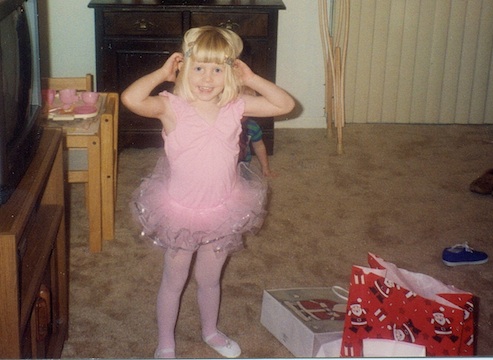
But I noticed a contrast between my childhood images and more recently taken images that I included on my Haiku page, for example, which were more focused on complicatedness of femininity as I do and do not live up to my gender.
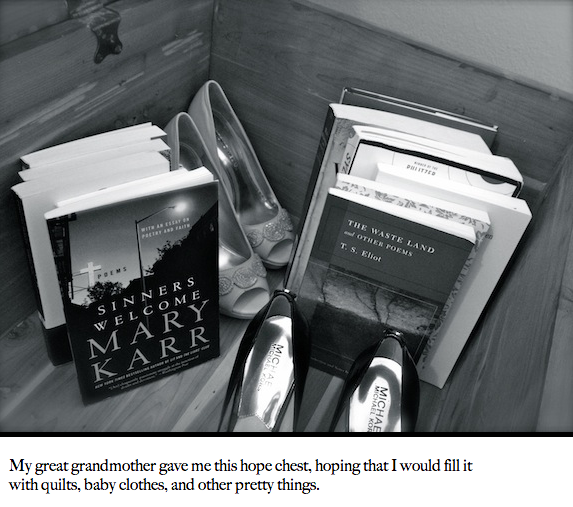
2. Does the mystory realize Ulmer’s aspirations?
I want to say yes, but I can only speak for myselves. From my experience, the mystory certainly helps egents confront themselves as troubled and limited. It was refreshing to do a project that asked me to write about personal, situated experiences/knowledges that I have collected over the years. But I should mention that I am predisposed to Ulmer’s project in some ways; I want the moments in writing when we can stop philosophizing, criticizing, and juxtaposing, and instead just say, “I am angry; I am sad; when I was four my father killed himself; I was abused at my last job; I am so hungry; I don’t know what to do with my life; I am not happy; I am happy; I am unsatisfied with these words because they aren’t doing what I want them to.” Because when I read something so sincere as, “I wish I believed in something,” I can leave myself. There is strategic solidarity there in that space, where we read the world together and come up with some raw emotion. Without empathy, we go nowhere. I hate writing without a living, breathing, feeling, blinking, digesting, hearing, seeing person in it. Ulmer’s project is most successful at teasing out the complex person(s) enmeshed in writing. But for the mystory to be successful, a participant must be willing to open themselves to and experiment with this exposure.
3. Can/should you learn Ulmer while learning HTML and CSS?
Overall, I think that deciphering coding while deciphering Ulmer is not for the faint of heart. But neither is the mystory. Coding was the part of this project that was most collaborative for me. My/story sort of belongs to everyone who is somehow a part of it . . . from the people whose code I borrowed and tweaked, to the people who are in the stories and pictures I put on the pages, to the people who helped me make adjustments in the code so I could (re)present myself and my experiences, to my professor who first showed me the kind of design I finally chose for my mystory pages. (See my side-scrolling Fetishscreen page, for example). Coding encourages dependency upon others—physically present classmates, instructors, and people who write code and post in help forums online. Read as a metaphor for one of the project’s purposes, coding reinforces the importance of others in the coming to hold and (re)creations of particular identities. For this reason, I think that to the extent that you can ever learn Ulmer and HTML/CSS, you should try to do both simultaneously. They complement each other. My side-scrolling layout represents countless conversations, Google searches, and demonstrations that all involved engagement with others.
For me—and I suspect others—while it was frustrating at moments, coding gave me a measure of control that Ulmer’s project stole from me. Padding, font size, header images—I could control those things. Personal memories, punctum stings, emotional responses—I could not always control. Coding can be a way to manage the sting of the mystory and postpedagogical risk, I think, by giving students access to one forum where they feel the interdependent agency that Ulmer’s project seeks to foster.
4. Should a mystory be public or private?
I would stray away from should. Sharing a mystory publicly can be very powerful, as it might invite the kind of “‘world’-travelling” that Maria Lugones (1997) advocated for in “Playfulness, ‘World’ Traveling, and Loving Perception.” In a public mystory, when a person shares the web of stories that have shaped them, they open up their worlds to the internet. There are very real risks involved professionally, personally, and academically when I share my worlds with an unknown audience. Lugones (1997) acknowledged potential drawbacks to "world"-travelling that might turn antagonistic, but she also defended this as a useful practice for identifying with others since it is “Only when we have travelled to each other’s ‘worlds’ are we fully subjects to each other (p. 158). Though I am hesitant to claim that the mystory, in itself, allows us to understand what it is to be another, I agree with Lugones that the benefits of better understanding far outweigh the risks of "world"-exposure and travel.
What I wonder about in regard to this question is whether or not the mystory needs an audience. I think that it does, but I don’t think this audience necessarily needs to be the whole Internet. The loss of control that accompanies posting anything personal on the Internet, let alone on your personal Web presence, is unsettling. This unsettling is vital to Ulmer’s project and to what I wanted to do with his project. But this unsettling can be dangerous when it is not responsibly attended to, since questions arise as to who it unsettles, to what extent, and for what purpose. Again, since the mystory plays with the notion that I am already an audience, that I am already receptive to and dependent on others, I can be the audience to my mystory because I doesn’t mean just me. There are problems with this inclusion of others in the mystory, however. Specifically, Megan M. McIntyre and I struggled with our ethical concerns surrounding the use of images that include other people, and we were bothered, at times, by the ways that these images might (mis)represent the experiences of others. The mystory, like a memory, isn't necessarily True, or right, and it certainly doesn't perfectly and precisely represent the stories of others or myself.
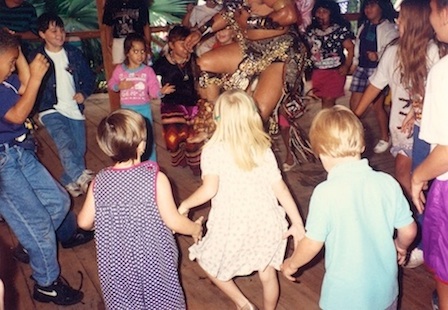
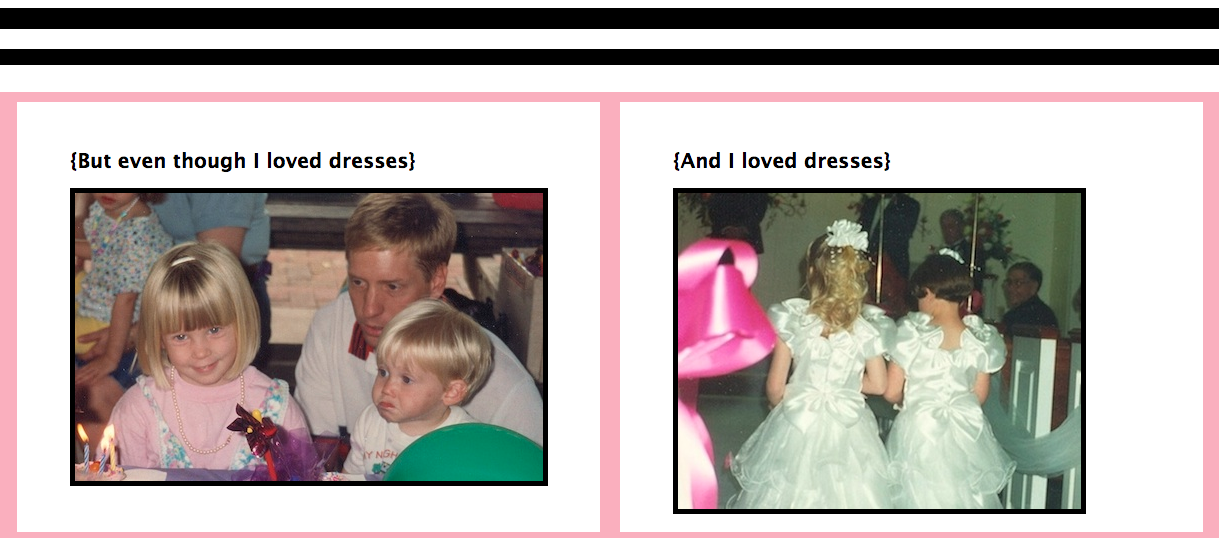
The mystory has to include other people because it is in engaging with others that we can trace our problems and attempt to understand ourselves. But it can also be dangerous to include others when the exposure that we are choosing to experience involves the exposure of others without their knowledge or consent.
5. Did you experience an aha moment during your mystory process?
My aha moment from my mystory process probably occurred while I was making my Wide Emblem. It was difficult to find an image that served as a symbol for me, so I chose a phrase instead: “The girl does not know what she means.” The double entendre intrigued me, since it could mean that the girl does not know what she means as she is, or the girl does not know what she means to others. The girl, who does not know, is also being (re)presented by another in the speaking of the phrase. Instead of a symbol, I also included two images—one taken in Chicago of flowers blooming in the midst of skyscrapers, and an image of me in front of the Chicago bean surrounded by others and reflected in various directions by the surface of the bean. I chose the former because I was impressed by the sight of the pink flowers blooming in spite of the city around them. I saw their growth and vibrancy as a kind of response to the city’s height and prestige. I chose the latter image because I am the only person in the photo facing the camera. I am part of the scene, but no one interacts with me or looks at me. The bean reflects the people in the picture and myself in various directions, so there is not one static vision of us, but multiple, distorted ways of seeing us. It is like I am providing testimony for a crowd of others by looking. But the thing above me casts our reflections into other directions too, beyond my influence or will. I liked the juxtaposition of these images and the phrase, and I realized that, in selecting these successive words and pictures instead of following the directions, I was refusing to make myself into a symbol. The images and the phrase actively resist becoming an easy symbol that means something. I do not trust symbols, and I did not want to reduce my experiences to one. At the end of my mystory process, I did not want to find my problem that guides my career, family, entertainment, and community discourse. I wanted to see the web of problems that encircle and shape me, and I wanted to dwell with them uncertainly. When I look at these images and read the phrase, I experience something—uncertainty, confusion, excitement, and resilience. I wanted to be constantly re/presented, not to represent myself. And that, I think, was my approach to the mystory and my goal, if I had one.
6. What particular part of your mystory is your favorite? Why?
My favorite part of my mystory is the Decision Scene page. I created this page that asked me to present a metaphor for the way I make decisions as I started to apply to Ph.D. programs. The uncertainty of this process led me to think of surrender and releasing control as ways to make decisions, and this immediately made me think of releasing balloons into the air. (What is more uncertain than releasing balloons to the sky?) As I went to buy balloons from the cashier, he asked me how many I wanted. The one balloon seemed sort of sad by itself, so I asked for five. I took them to my backyard and released them slowly, watching them fade away until I could not see them anymore. I could not tell if they had gone on or dissolved. But I found it strangely comforting to know that all five balloons were tethered together. Seeing the balloons floating so far away made me think of the feeling of homesickness. The balloons could not get back and I could not bring them back; their release was permanent. This is my favorite page on my mystory because it is nostalgic for me—remembering the uncertainty of that period of time that led me to perform this project in this way. It reminds me that while I may not have absolute control over decisions I make, I also never make decisions in isolation. It reminds me that sometimes making decisions does not mean controlling the outcome, but opening a possibility.
7. What else do you want to say?
We’re not in Kansas anymore. Ulmer (2003) claimed, “When you go online, even if your body is in Kansas, your spirit is not in Kansas anymore (to allude to the Wizard of Oz)” (178). Like Dorothy and Toto traveling to Oz, making a mystory can feel like a whirlwind that remixes our identities, the worlds we live in, the monsters we fear, and the people we interact with until these things are indecipherable from each other. Like Dorothy, we may want to go home, but unlike Dorothy, we have no ruby slippers. The sting of the mystory, I think, is the realization that going home is impossible since home is always transforming around us—since home, it turns out, is and always has been shaped by interactions between forces that evade our control. Mapping felts is vital for egents to learn to navigate what Ulmer (2003) called ‘the experience of going online or putting your image into cyberspace” as it shows us that we have never been neatly in control (p. 178). And the mystory is essential in showing us ways to claim a measure of responsibility for (re)building homes for ourselves online that are attuned to others, complexly situated, and always shifting around us.
